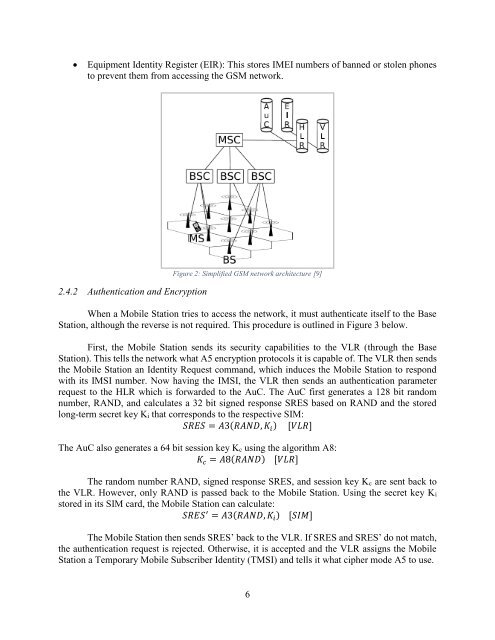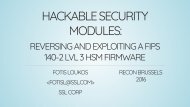IMSI Catchers and Mobile Security
EAS499Honors-IMSICatchersandMobileSecurity-V18F-1
EAS499Honors-IMSICatchersandMobileSecurity-V18F-1
Create successful ePaper yourself
Turn your PDF publications into a flip-book with our unique Google optimized e-Paper software.
Equipment Identity Register (EIR): This stores IMEI numbers of banned or stolen phones<br />
to prevent them from accessing the GSM network.<br />
2.4.2 Authentication <strong>and</strong> Encryption<br />
Figure 2: Simplified GSM network architecture [9]<br />
When a <strong>Mobile</strong> Station tries to access the network, it must authenticate itself to the Base<br />
Station, although the reverse is not required. This procedure is outlined in Figure 3 below.<br />
First, the <strong>Mobile</strong> Station sends its security capabilities to the VLR (through the Base<br />
Station). This tells the network what A5 encryption protocols it is capable of. The VLR then sends<br />
the <strong>Mobile</strong> Station an Identity Request comm<strong>and</strong>, which induces the <strong>Mobile</strong> Station to respond<br />
with its <strong>IMSI</strong> number. Now having the <strong>IMSI</strong>, the VLR then sends an authentication parameter<br />
request to the HLR which is forwarded to the AuC. The AuC first generates a 128 bit r<strong>and</strong>om<br />
number, RAND, <strong>and</strong> calculates a 32 bit signed response SRES based on RAND <strong>and</strong> the stored<br />
long-term secret key Ki that corresponds to the respective SIM:<br />
SRES = A3(RAND, K i ) [VLR]<br />
The AuC also generates a 64 bit session key Kc using the algorithm A8:<br />
K c = A8(RAND) [VLR]<br />
The r<strong>and</strong>om number RAND, signed response SRES, <strong>and</strong> session key Kc are sent back to<br />
the VLR. However, only RAND is passed back to the <strong>Mobile</strong> Station. Using the secret key Ki<br />
stored in its SIM card, the <strong>Mobile</strong> Station can calculate:<br />
SRES ′ = A3(RAND, K i ) [SIM]<br />
The <strong>Mobile</strong> Station then sends SRES’ back to the VLR. If SRES <strong>and</strong> SRES’ do not match,<br />
the authentication request is rejected. Otherwise, it is accepted <strong>and</strong> the VLR assigns the <strong>Mobile</strong><br />
Station a Temporary <strong>Mobile</strong> Subscriber Identity (TMSI) <strong>and</strong> tells it what cipher mode A5 to use.<br />
6



